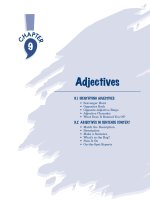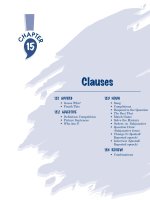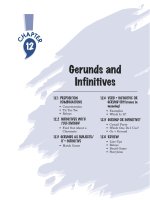fun With Grammar - Nouns
Bạn đang xem bản rút gọn của tài liệu. Xem và tải ngay bản đầy đủ của tài liệu tại đây (305.79 KB, 19 trang )
6.1 SINGULAR–PLURAL
• Fill-in Chart
• Relay
• Mouse Story
• Tic Tac Toe
• Concentration
• Ball Toss
6.2 NOUNS AND
ADJECTIVES
• Picture Sentences
6.3 AGREEMENT
• Error Analysis
6.4 COUNT–NONCOUNT
NOUNS
• Scavenger Hunt 1
• Scavenger Hunt 2
(Categories)
• Name That Noun
• Grammar’s Wild
• What’s in Your
Refrigerator/Kitchen?
6.5 ARTICLES
• Scavenger Hunt 3
• Article Pass-Along
• Error Analysis Draw
NOUNS
6
6.1 SINGULAR–PLURAL
1. FILL-IN CHART
Materials:
Worksheet 39A, 39B, or 39C
Dynamic:
Pairs
Time:
20 minutes
Procedure:
1. Have students work together in pairs to complete the worksheet,
using the worksheet appropriate to their level. (39A is for the
lowest level.)
2. Check each pair’s worksheet as they finish. The first pair to
complete the chart successfully wins. If some answers are
incorrect, you can either indicate the incorrect answers or tell
them how many are incorrect. The game then continues until one
pair has all correct answers.
2. RELAY
Materials:
Board, 2 markers or pieces of chalk
Dynamic:
Teams
Time:
10 minutes
Procedure:
1. Divide the class into two teams and have each line up on the
opposite side of the room.
2. On the board, make two lists of the same singular nouns, but in
different order. (Variation: list the plural forms.)
3. Give the first person in line a piece of chalk or marker (depending
on your board type). He/She goes to the board and writes the
correct plural form of one word, then passes his/her marker to the
next person in line. Each student can write only one plural form,
but may correct as many incorrect forms on the board as he/she
wants.
4. When you call “Time!” the team with the most correct answers
wins.
128
129
3. MOUSE STORY
Materials:
Worksheet 40
Dynamic:
Pairs
Time:
20 minutes
Procedure:
1. Divide the class into pairs, and give each pair a copy of the
worksheet.
2. The students read the story and change the underlined nouns to
the plural form if necessary. Be sure they understand that some of
the underlined nouns will not need to be changed.
3. Go over the answers when pairs have finished.
Variation 1:
If this game is a competition, tell the students to call you over as soon
as they finish. The first pair who has all the answers correct, wins. If a
pair calls you over but has mistakes, the game proceeds until a
winning paper is found.
Variation 2:
You may want to use this story in other ways. After you have checked
the answers, you can divide the class into small groups and have them
practice retelling the story in their group without using the worksheet,
and then tell the story to you. The group that most closely retells the
story “wins.”
Variation 3:
For oral practice, have the pairs role play the story. They will be
practicing the singular/plural forms as they act out the story. Choose
one pair (or ask for volunteers) to present its role play to the class.
4. TIC TAC TOE
Materials:
Worksheet 41, board
Dynamic:
Teams
Time:
10 minutes
Procedure:
1. Make a tic tac toe grid on the board with singular (or plural) forms
of nouns. Divide the class into two teams.
2. The teams take turns coming to the board and writing in one
plural (or singular) form under the word of their choice. If a
student from team X writes a correct form, he/she then marks a
large X over that space. When team O writes a correct response, it
marks a large O over the space.
3. The first team that succeeds in having three of its marks in a row
is the winner.
NOTE: You may want to discuss blocking strategy, but usually
students can figure it out themselves or are limited to choosing a
blank with a word whose form they are sure of.
FOLLOW-UP: Divide the class into groups of three and give each
group a copy of the worksheet. There are three games on the
worksheet. Two students will be the players (X and O), and the
third student is the judge who may have his/her book open to check
the answers. In the second and third games, the students alternate
roles, so that each student gets to play two games and is a judge in
a third game.
5. CONCENTRATION
Materials:
Board
Dynamic:
Groups
Time:
20 minutes
Procedure:
1. Draw a blank grid with only numbers on the board (see below).
Divide the class into teams of about five.
2. Each team takes turns calling out two numbers, trying to match a
singular and a plural form. As the number is called, write in the
word that corresponds to the number from your filled-in grid.
Caution the teams to wait until you write the word before they call
out a second number.
3. If a team makes a match, leave the answers on the board and
draw an “X” through them. The team then takes another turn. If
the team does not make a match, erase the two words.
4. Team members may talk together, but remind them that this is
also a memory game, so no writing is allowed.
NOTE: You can use any size grid, but be sure to have an even
number of spaces. You can use this game to review plural spelling
rules (as in the example below), irregular plural forms, or a
combination.
On the board:
12345
678910
11 12 13 14 15
16 17 18 19 20
On the instructor’s paper:
1 match 2 dishes 3 country 4 glass 5 radios
6 monkey 7 toy 8 baby 9 countries 10 babies
11 potato 12 glasses 13 matches 14 leaves 15 toys
16 potatoes 17 dish 18 monkeys 19 radio 20 leaf
130
131
6. BALL TOSS
Materials:
Any soft ball or beanbag
Dynamic:
Whole class
Time:
5 minutes
Procedure:
1. Have students sit or stand in a circle. Decide if you want them to
provide the singular or the plural form when they catch the ball.
2. Begin the game by tossing the ball to a student and saying a noun.
If you said a singular noun, the student catching the ball must
provide the plural form. That student then throws the ball to
another student and says a new noun.
Example: Instructor: city
Student A: cities
mouse
Student B: mice
child
Student C: children
radio, etc.
6.2 NOUNS AND ADJECTIVES
1. PICTURE SENTENCES
Materials:
Large magazine pictures
Dynamic:
Pairs
Time:
15 minutes
Procedure:
1. Give each pair of students a magazine picture (pictures from
picture dictionaries may work well also). The picture should have
several objects in it. Have the pairs write 5–10 sentences about the
picture, using an adjective and a noun in each sentence.
2. When the pairs have finished, have the students in each pair take
turns holding up their picture and reading out their sentences.
132
6.3 AGREEMENT
1. ERROR ANALYSIS
Materials:
Worksheet 42A or 42B
Dynamic:
Small groups
Time:
25 minutes
Procedure:
1. Divide students into small groups of approximately three. Give
each group a copy of the worksheet appropriate to your class level.
2. Instruct the members of each group to work together to find the
errors indicated after each paragraph.
3. Students exchange papers with another group. Go over the
answers to make sure each group found the errors indicated and
can correct them.
6.4 COUNT–NONCOUNT NOUNS
1. SCAVENGER HUNT 1
Materials:
Magazines to share in class
Dynamic:
Small groups
Time:
15 minutes
Procedure:
1. Arrange the class into groups of three or four. Give each group
several magazines to cut up. (You may want to assign students to
bring in magazines in advance, or provide them yourself.)
2. Have the groups look for noncount nouns and cut out pictures
containing as many of them as they can find in the time provided.
The group that finds the most correct pictures wins. (That is, if a
group cuts out a picture of a table, for example, that picture cannot
be counted.)
Variation:
Assign a certain number of count and noncount nouns (perhaps 10 of
each) and a time limit. The group that finds the most of each, wins.
SUGGESTION: Instead of giving magazines to each group, you can
keep the magazines on a front desk or in another central location.
Each group can take two. When a group finishes with a magazine,
the students return it to the table and exchange it for another.
Instead of cutting out the pictures, the group can list the objects
they found on a paper.
133
2. SCAVENGER HUNT 2 (Categories)
Materials:
Magazines to share in class
Dynamic:
Small groups
Time:
15 minutes
Procedure:
1. Arrange students in groups of three or four. Give each group
several magazines to cut up (or make lists from). (Either have
students bring in magazines as a previous homework assignment
or provide them yourself.)
2. Assign a category of noncount nouns (liquids, abstracts, weather,
meat, whole groups, etc.) and a specific time limit. The group with
the most pictures of objects in the stated category at the end of the
time period, wins.
Variation:
Give each group a different category. At the end of the time period,
each group reads out its list (or pictures), perhaps writing the items on
the board. The class decides if they are appropriate to the category.
The group with the most acceptable answers wins.
3. NAME THAT NOUN
Materials:
Objects brought in by students
Dynamic:
Whole class
Time:
15 minutes
Procedure:
1. The day before, tell students to bring in two objects from home––
one a count noun and one a noncount noun. Encourage them to
find unusual items.
2. Collect the objects and distribute them around the class with a
number for each.
3. Have the students walk around, looking at the objects. On a paper,
they write what noun they think each number indicates and
whether it is count or noncount. They can write only one noun for
each number (so if two apples and a pear have the same number,
they must write “fruit”).
4. Go over the answers and have students check how many they got
correct.
SUGGESTION: Bring in your own objects to use as noncount nouns
because these will be more difficult for students to find.









